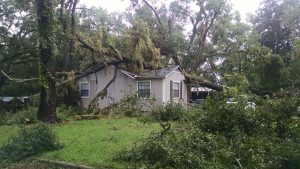
The Management and Staff of Cotton States Properties is sending thoughts and prayers to all those millions of people who were adversely affected by Hurricane Harvey and Hurricane Irma. Although these storms are now over, we are still in hurricane season and winter will be on our door step. Below you will find 10 steps written by Sandra Pawula on how to prepare for a natural disaster. We hope these tips will help you and your family prepare for what might come your way.
So how do you prepare for a disaster? This is what I’ve learned from my recent research.
Disaster preparedness is actual complex if you start thinking about actions like bolting down your gas water heater and bracing overhead light fixtures. All these types of actions are important to consider, but the first step is to create a disaster preparedness kit.
The following tips cover only the essential items you need to help you cope in response to a disaster. There’s more to consider, but these steps will give you a good start. Remember, the bottom line is water, food, and shelter. In Japan, more than 2 million people are without water. Another 500,000 are homeless. These are real possibilities. So focus on the priorities first. Then, add the other items to your kit.
Keep your supplies in an easy to carry kit. There’s actually quite a lot on this list so use your imagination when it comes to an appropriate container. Store your kit in an accessible place, one that will be within reach once a disaster strikes. It’s also wise to have a set of basic emergency supplies in your car and at work.
These are the most essential items:
- Water
1-2 gallons of water per person, per day. A 3-day supply for evacuation, a two-week supply at home.
- Food
Easy to prepare, non perishable items and a mechanical can opener. Canned soup, meat, vegetables, and fruit. A 3-day supply for evacuation, a two-week supply at home. For food preparation, have on hand a simple barbeque, charcoal and starter fuel or 1 propane unit with 2 canisters of propane and some basic cooking utensils. Don’t forget waterproof matches or lighters.
- Shelter
An emergency blanket, sleeping bag or regular blankets, and tent.
- Medical
First aid kit, a supply of essential medicines for at least a week, other crucial medical supplies like an inhaler.
- Light
Flashlights, extra batteries, and extra bulbs. Candles. Waterproof matches or lighter.
- Radio
A battery-powered AM/FM radio.
- Cash
Cash machines won’t work without electricity. Have a minimum of $50 on hand in small bills plus phone change.
- Cell Phone and Charger
Although a cell phone may not work in a disaster, it might also be your line to life-saving support.
- Sanitation and Personal Hygiene Items
Toilet paper, toothbrush, soap and other essential supplies.
- Personal Documents
Driver’s license, birth certificate, passports, insurance policies, proof of address or lease, medication list and medical information, copies of credit cards, checks.
Everyone’s situation will vary so you need to adapt the list to your own circumstances and the types of disasters that might occur in your region. If you are able to drive, there’s no guarantee you will be able to obtain gas since fuel pumps depend upon electricity.
In addition to creating a disaster preparedness kit with the items like the ones listed above, the Red Cross also recommends taking time to:
- create an emergency plan with your family;
- educate yourself and your family about the type of disasters that might occur in your community;
- have one household member trained in first aid and CPR/AED.
Overwhelmed, hesitant, or indifferent? Some of us find it challenging to prepare for a disaster. What holds us back? The Vizier explored this question in his excellent article 5 Factors that Hinder Preparations. You might want to start there if you find the thought of disaster preparation difficult to embrace.
Keeping It Simple
I suggest tying to prepare in a simple but complete way. Do only the necessary without going overboard. Given the fragility of the environment, it’s not useful to over-buy unnecessary, ecologically unsound items.
Not all the supplies above will necessarily make the grade from a green living perspective. I would love to hear your suggestions for a greener approach to disaster preparedness.
There’s more to disaster preparation that this basic list, but I hope this list will inspire you to begin or fine tune your preparations further.
Life is precious. Preparation saves lives. It’s that simple.
Resource: The Red Cross offers a full range of Emergency-Specific Preparedness Information. Whether you need to prepare for a tsunami, earthquake, winter storms, oil spill, or another threat, you will find the comprehensive information you need at the Red Cross.


 © 2024 Cotton States Properties. All Rights Reserved.
© 2024 Cotton States Properties. All Rights Reserved.